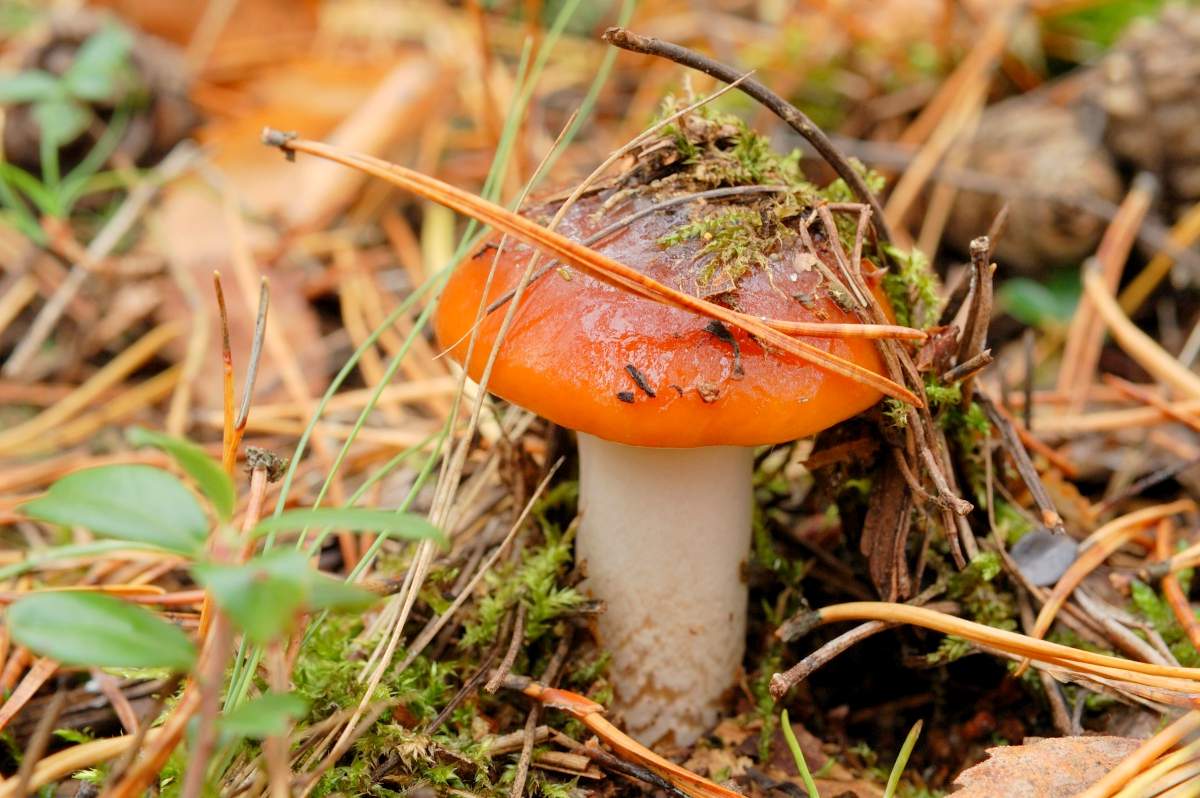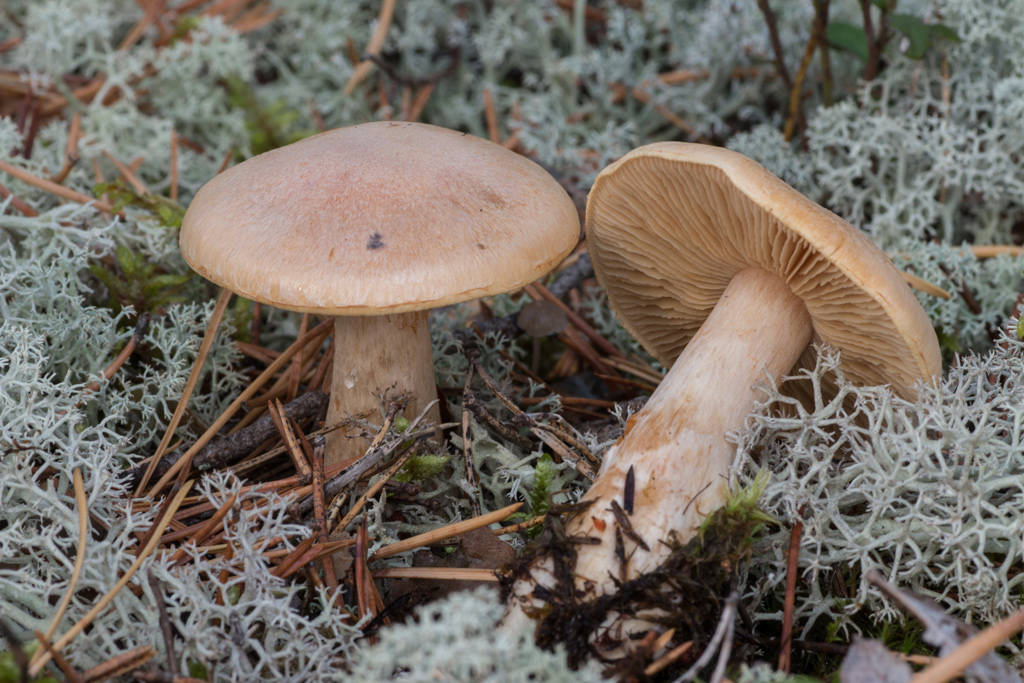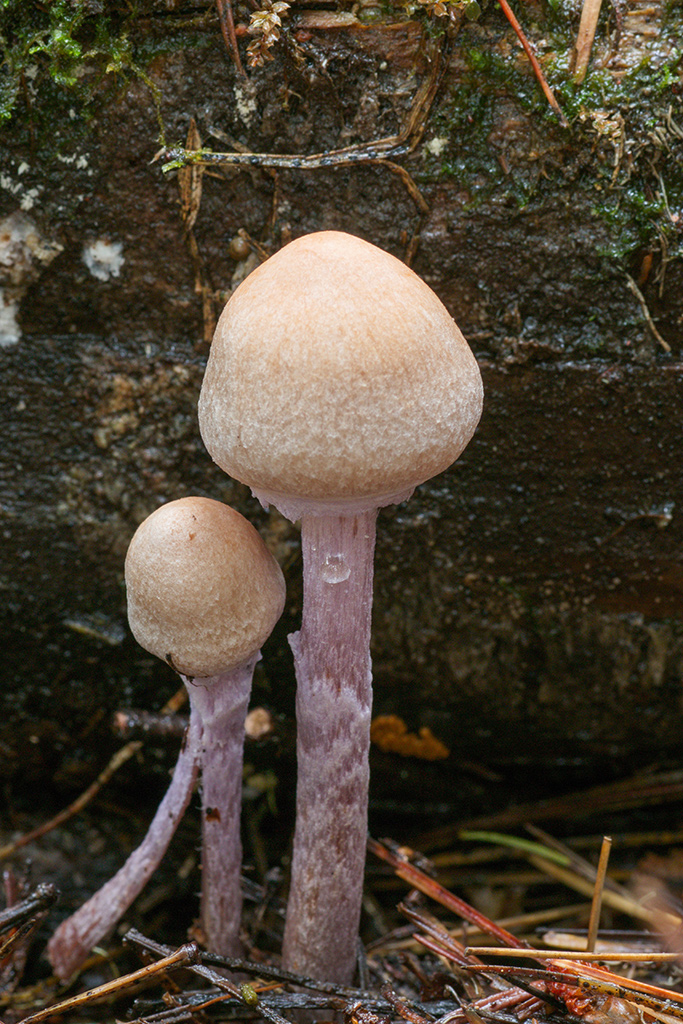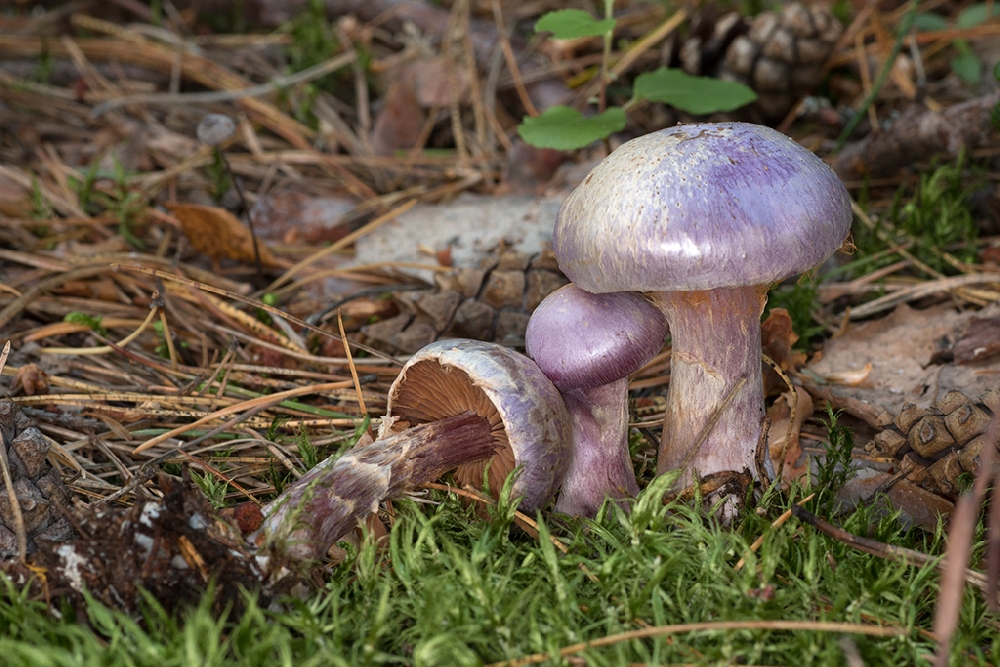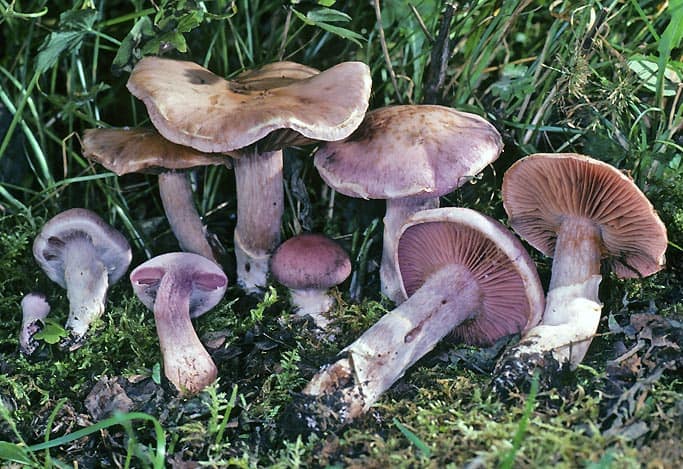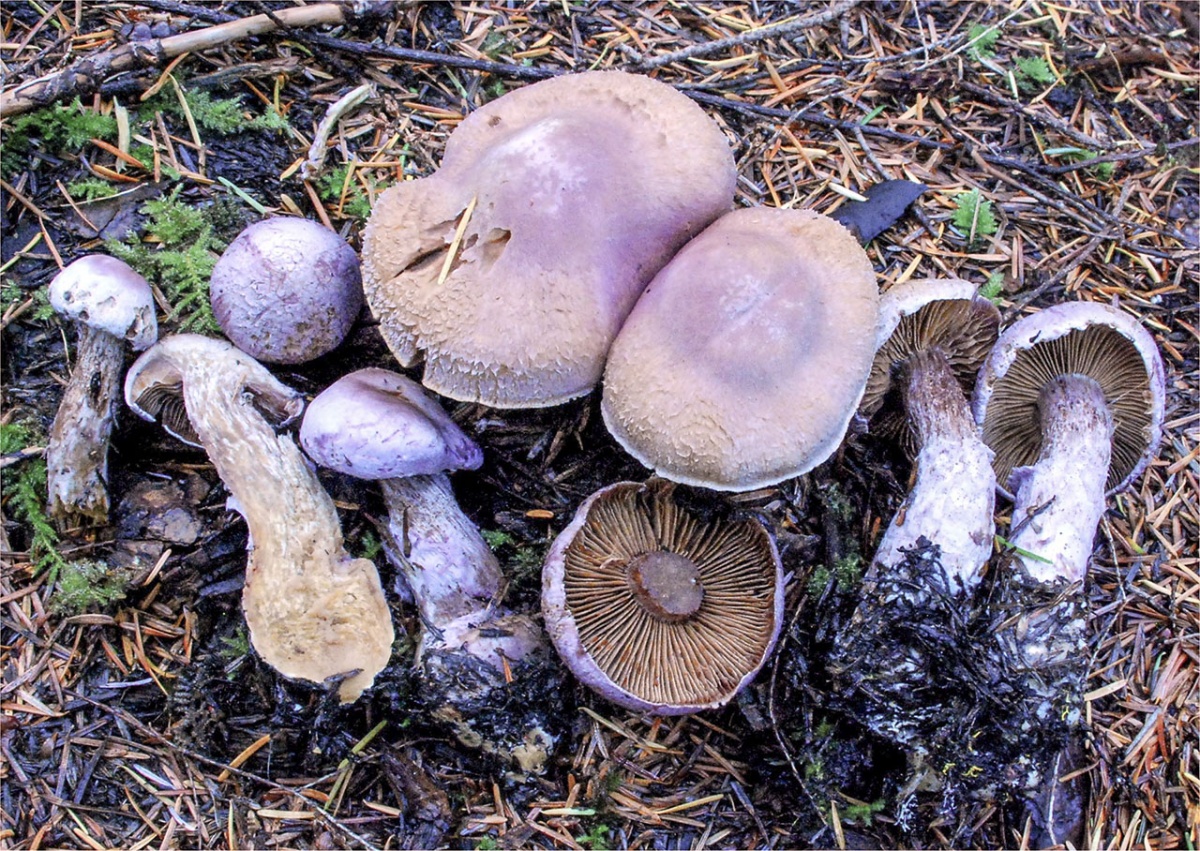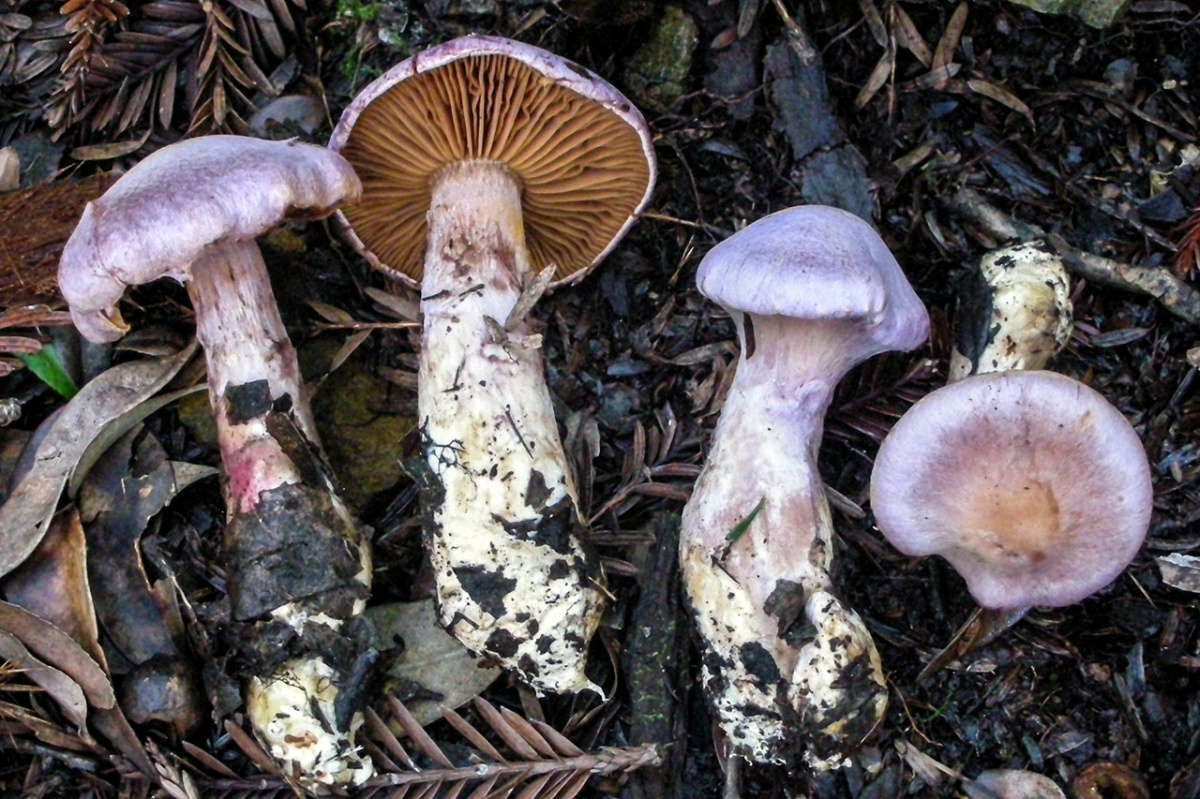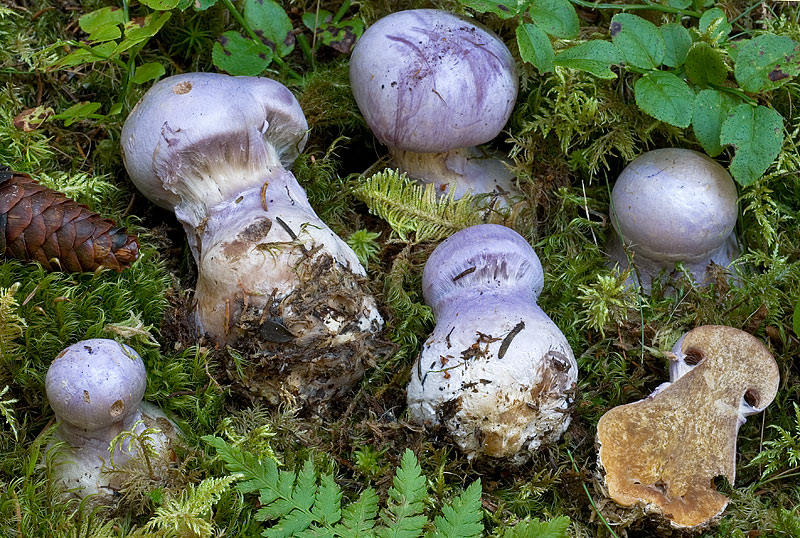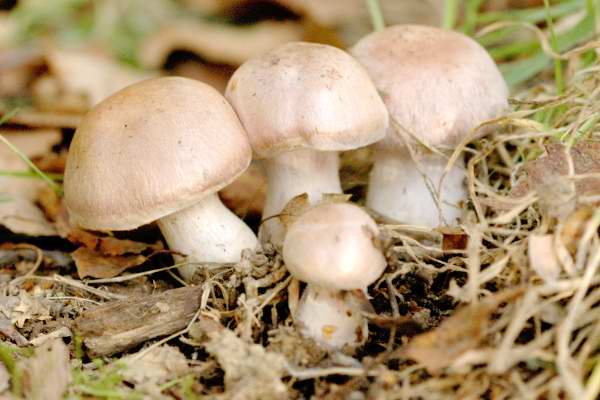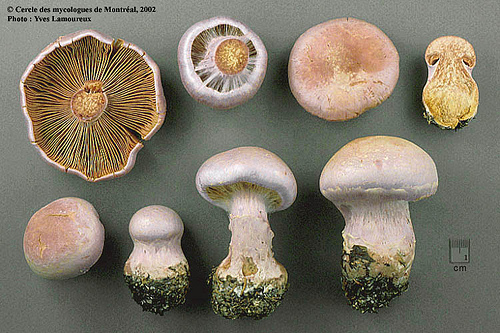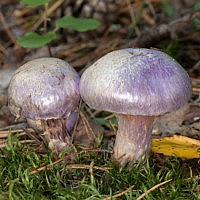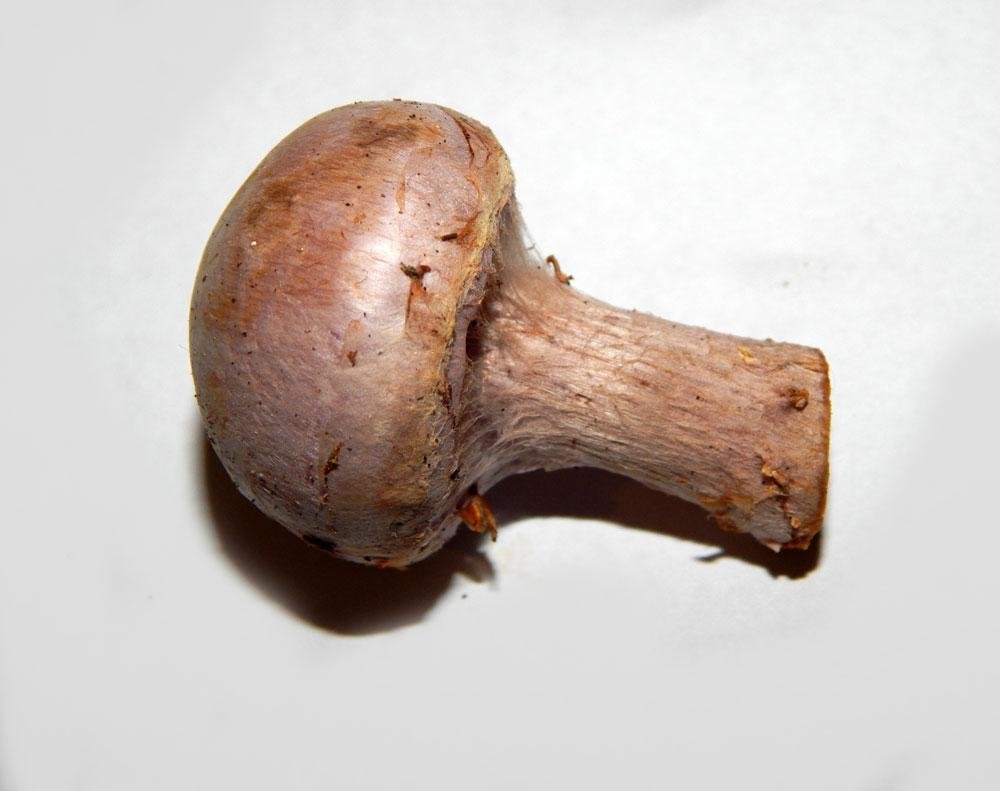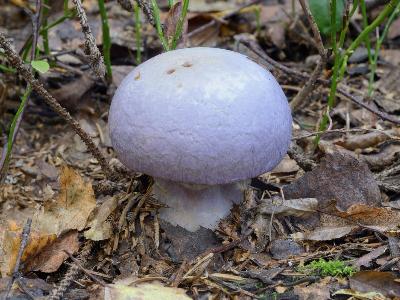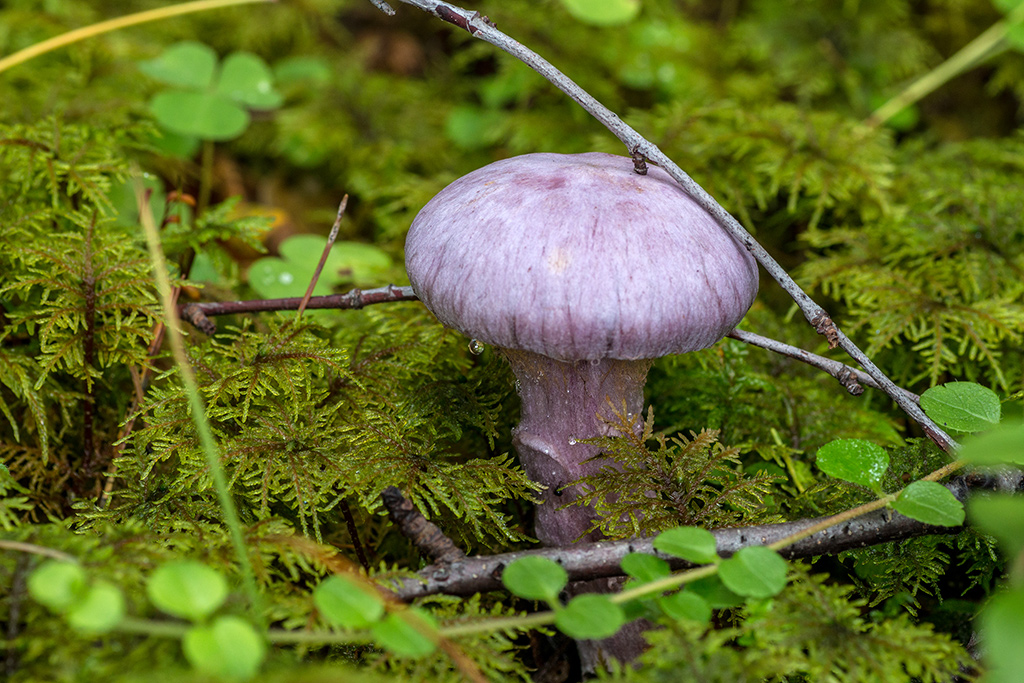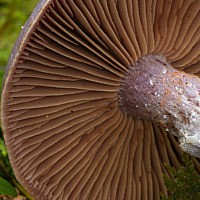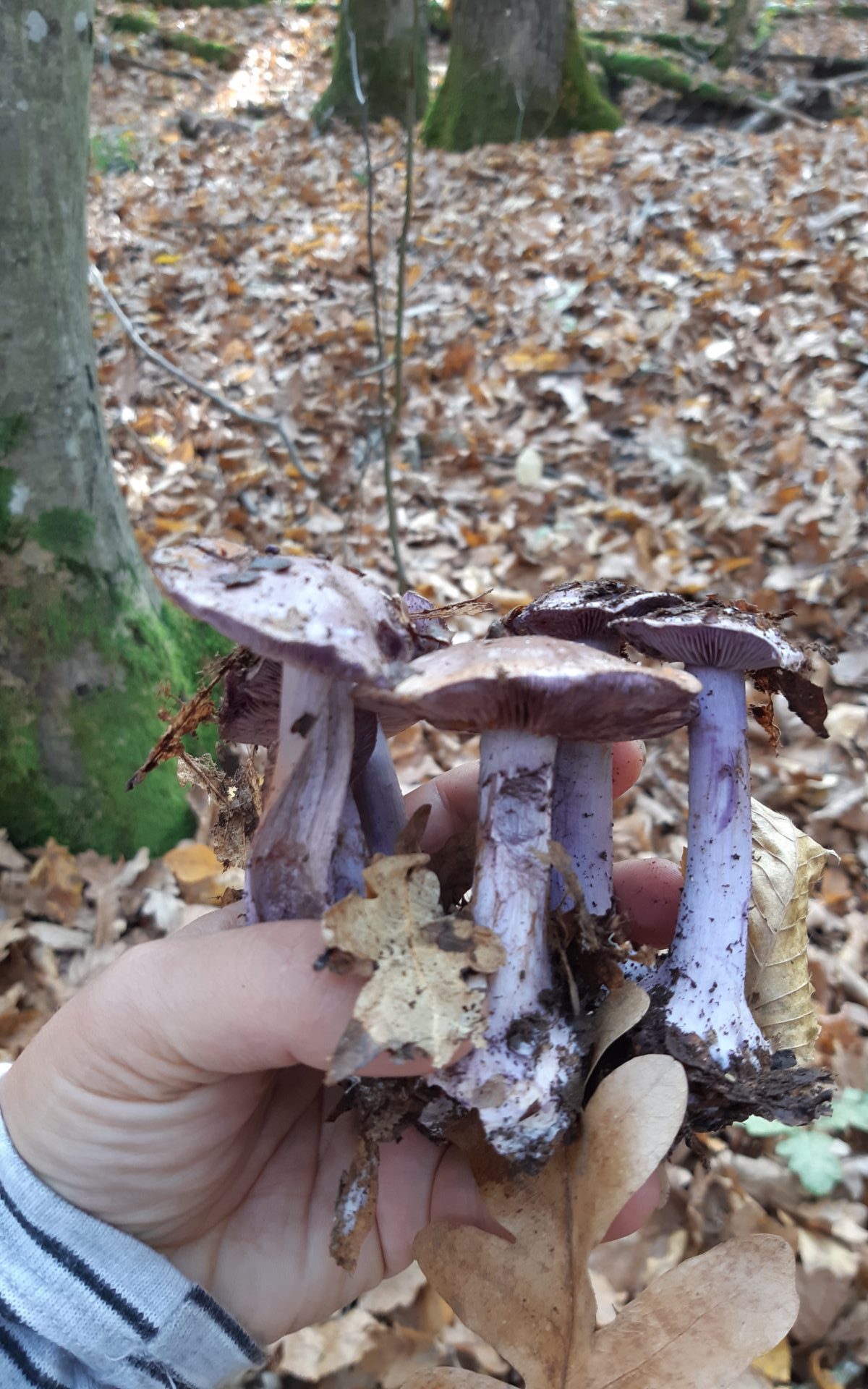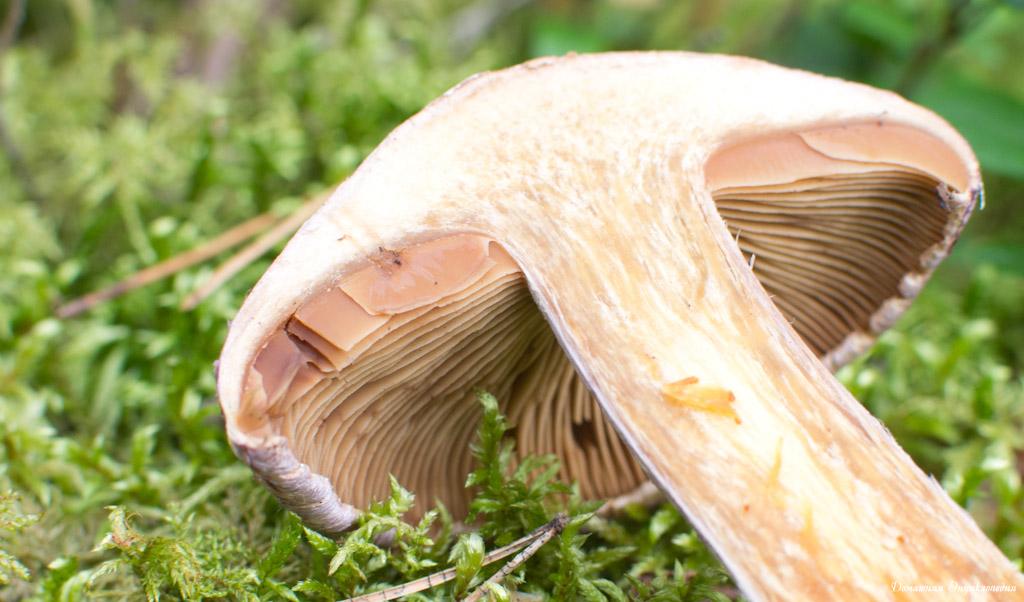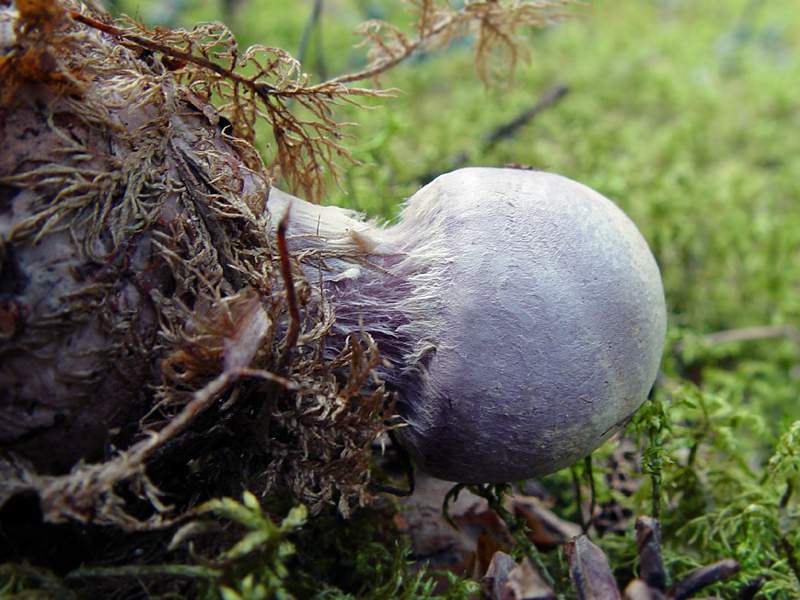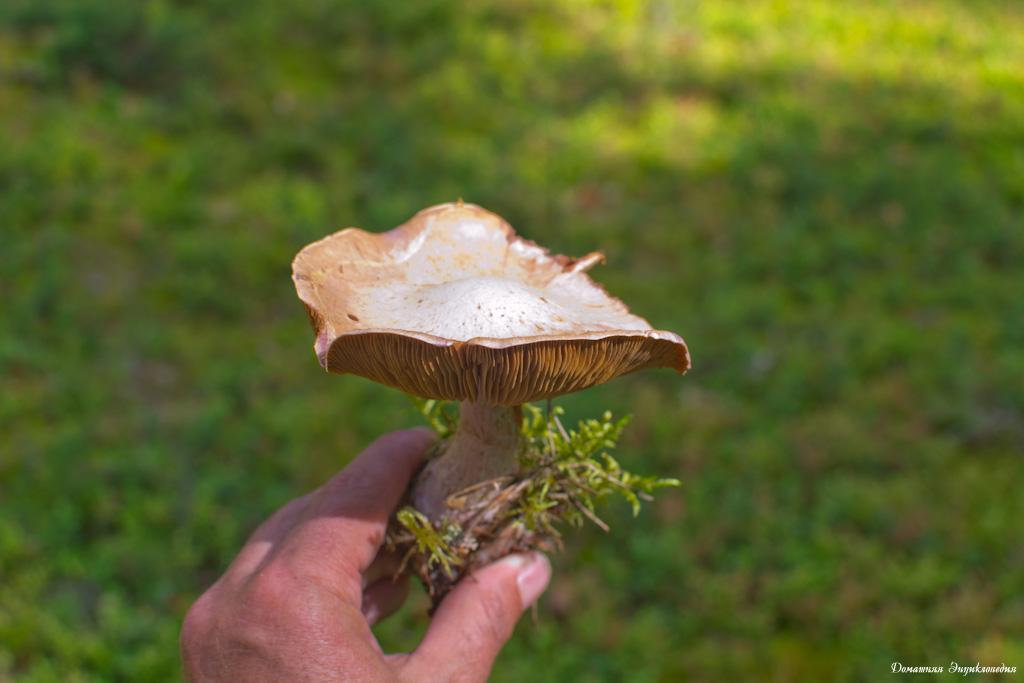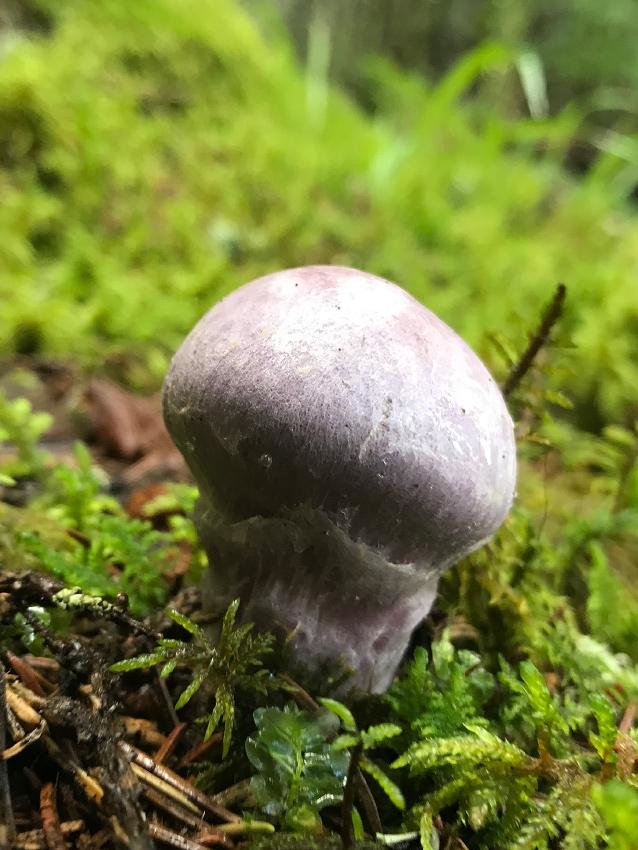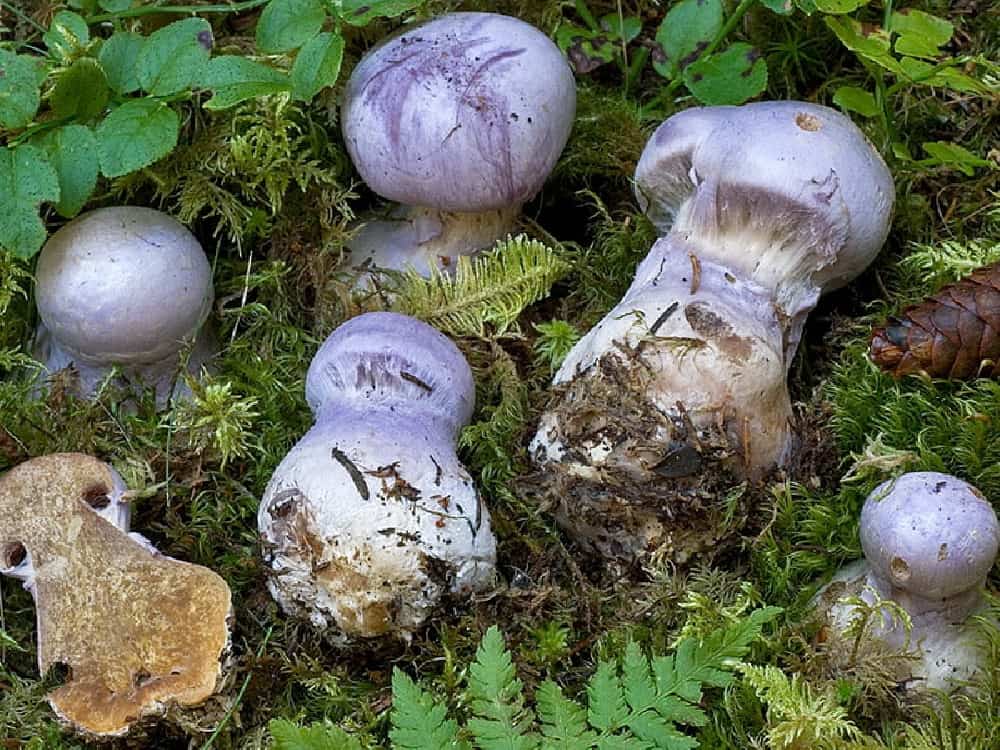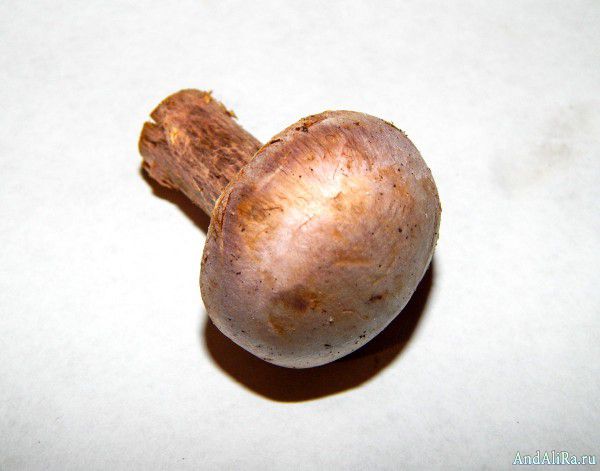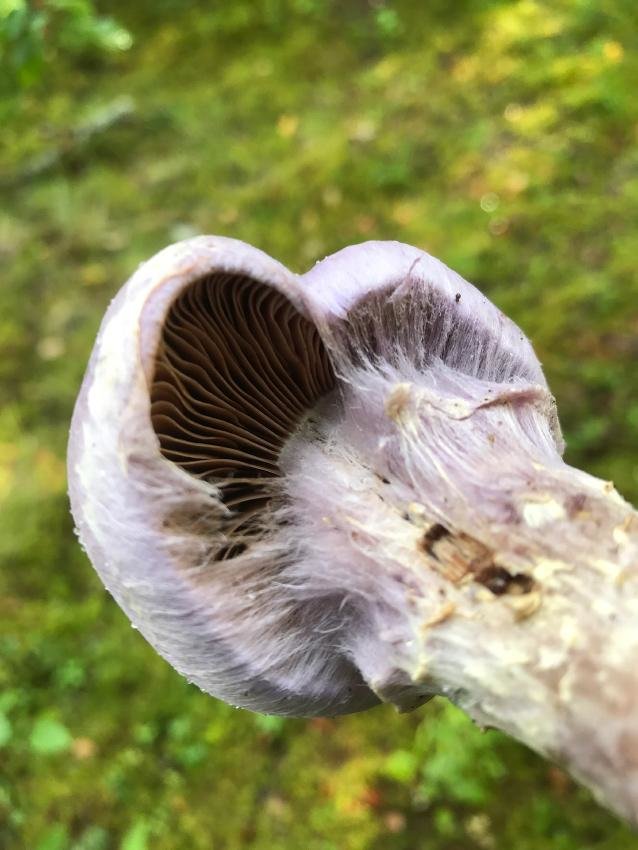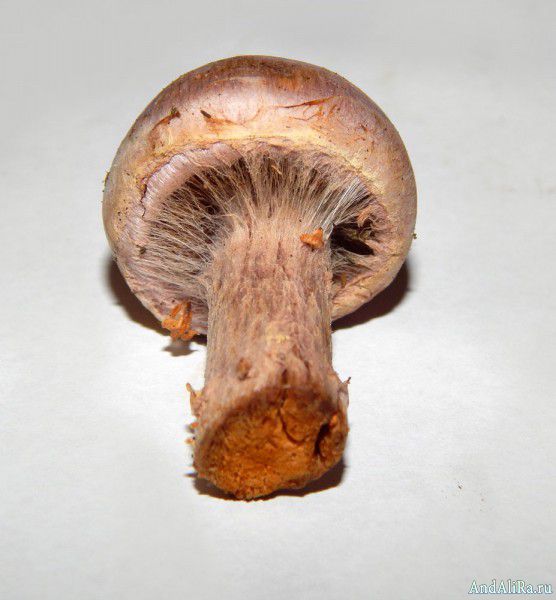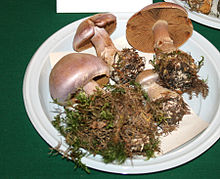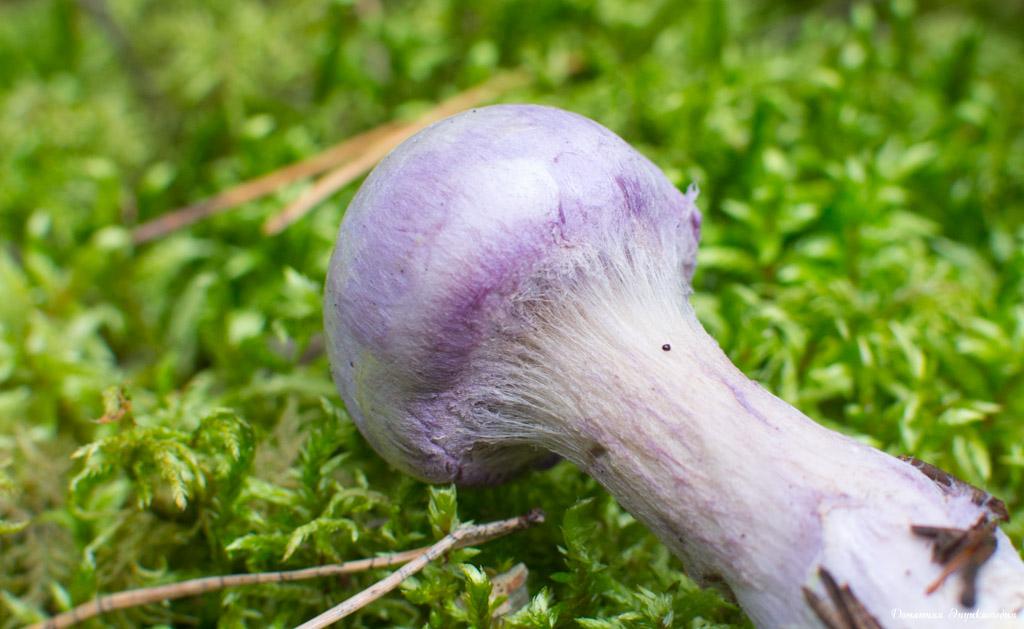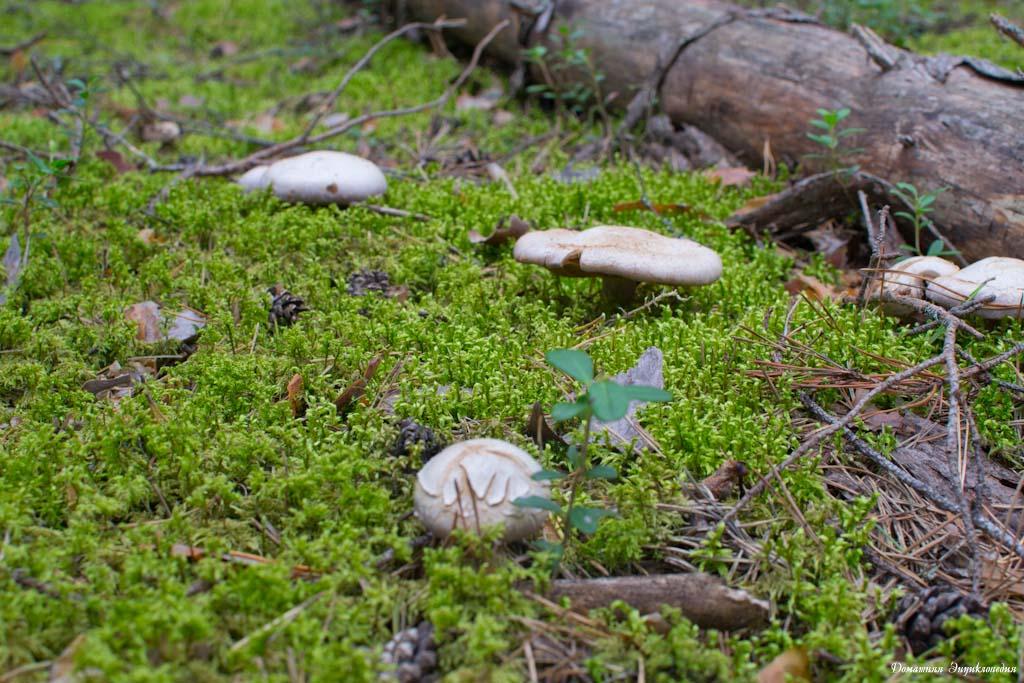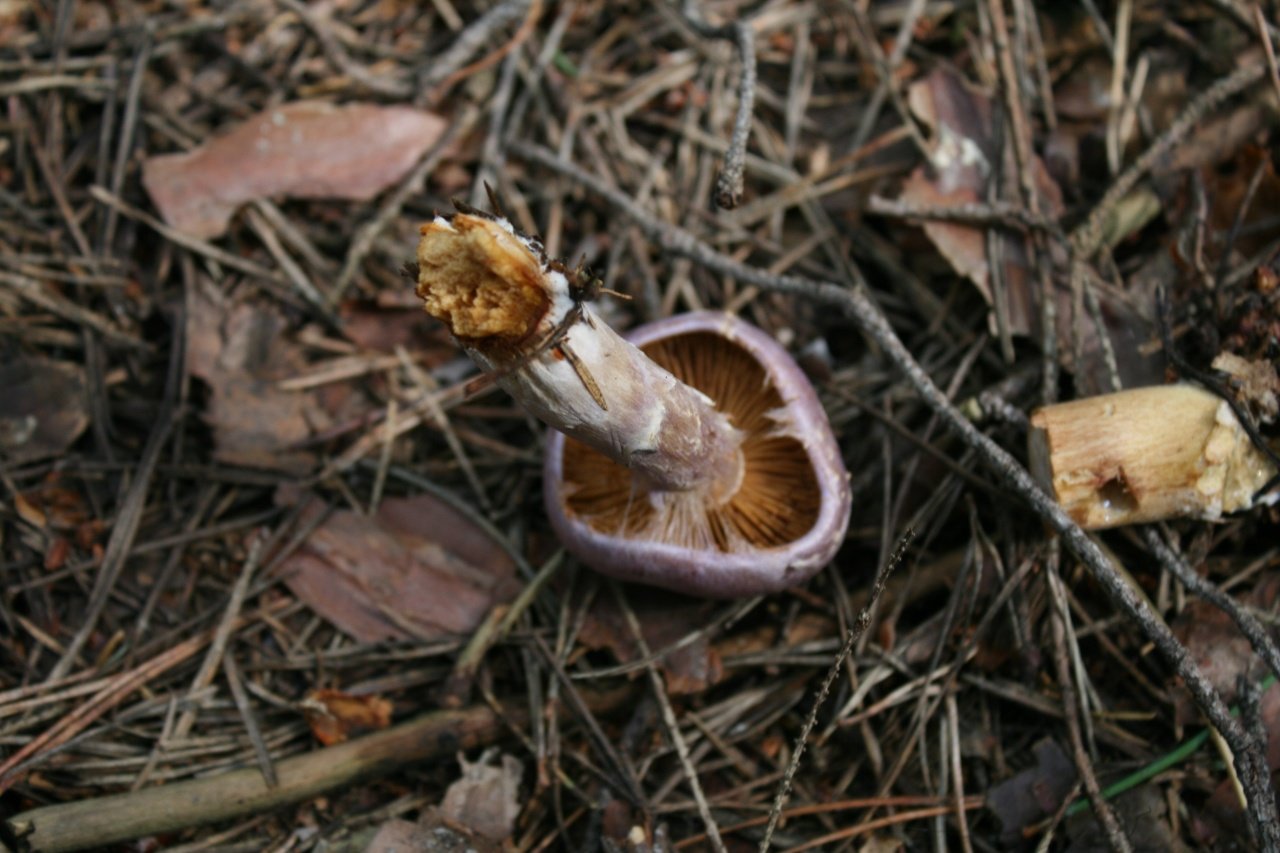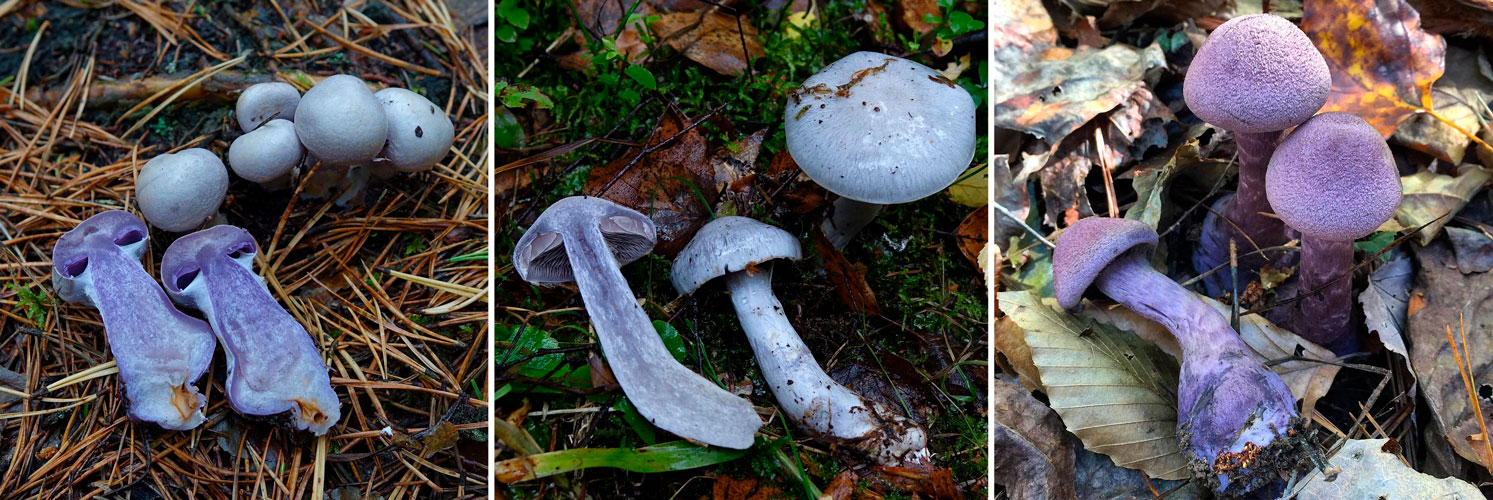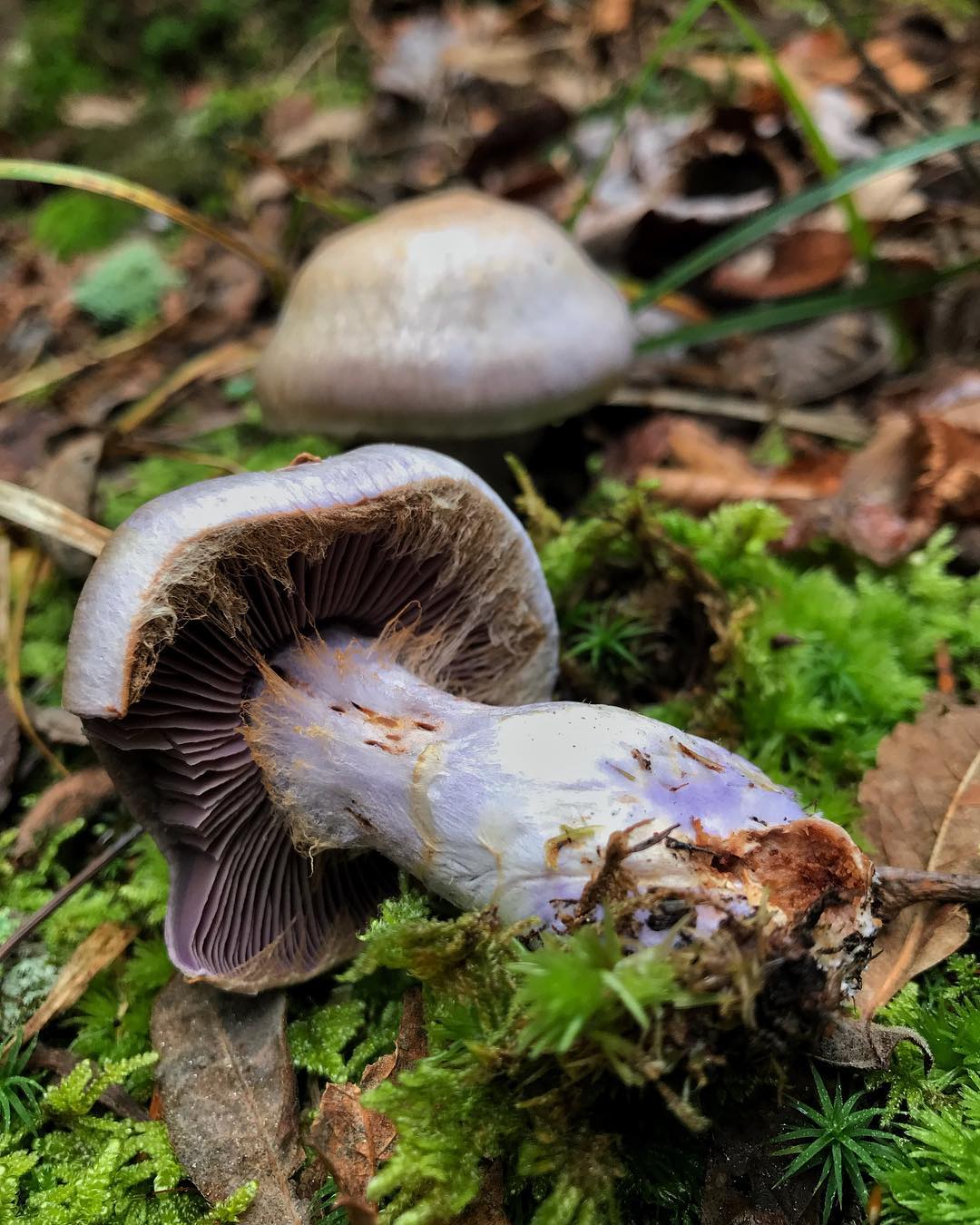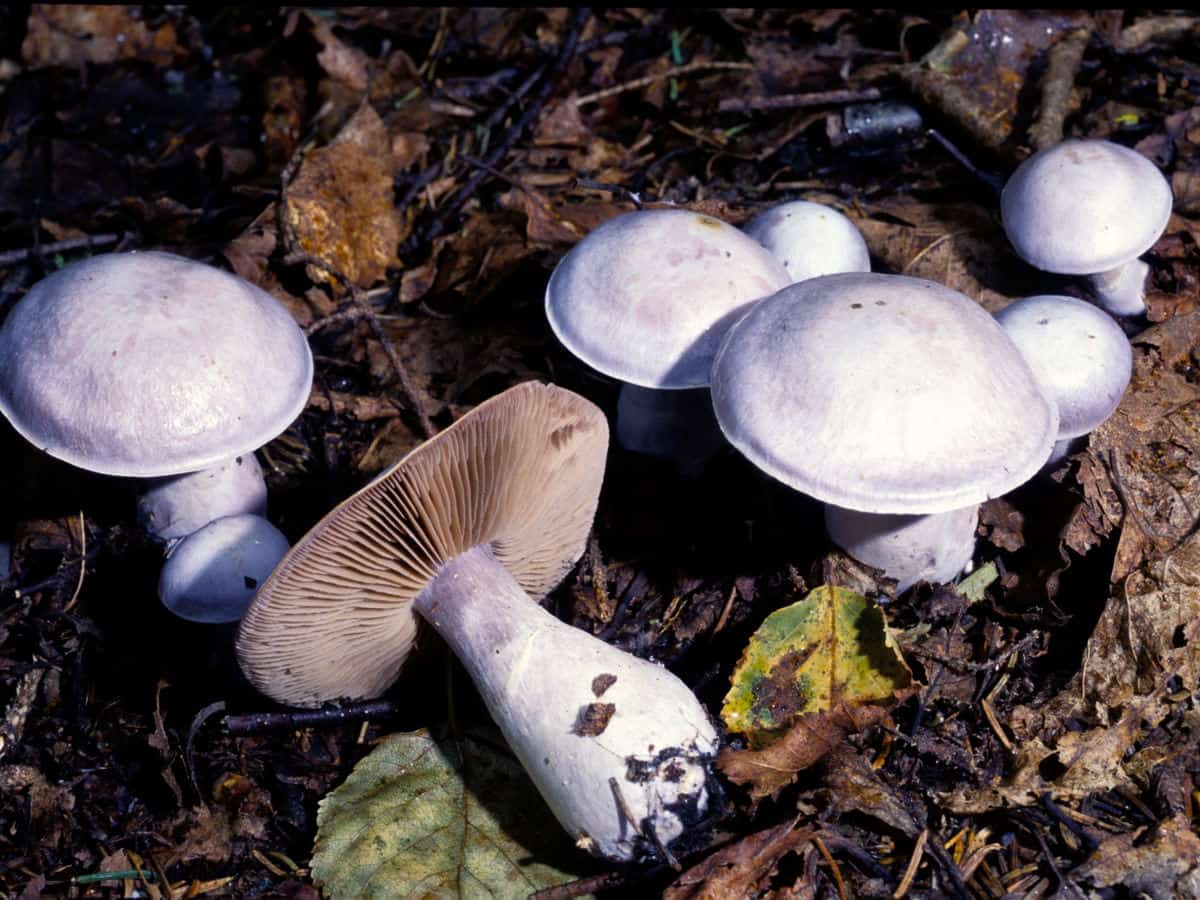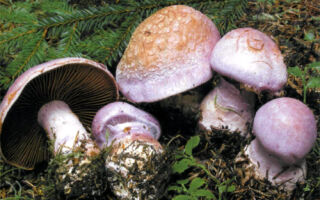Taxonomy, characteristics and description of the structure of the purple mushroom
Goat webcap (Latin name Cortinarius traganus), popularly also known as "smelly" or "goaty". It belongs to the genus Webinnikov (Webinnikovy family) and the class of agaricomycetes (lamellar). This fruiting body was nicknamed smelly for the fact that it has a particularly unpleasant, chemical aroma, reminiscent of the smell of acetylene or sexually mature goat. It is considered an inedible species.
The cap of this mushroom is rather large, since it reaches a diameter of 6 to 12 cm.In immature representatives of the genus, it has a regular rounded shape with edges slightly tucked inward. As it grows, it opens, however, a slight bulge remains in the center. The surface of the cap is dry and velvety to the touch. In young specimens, it is purple, however, over time, it acquires a bluish tint.
The fungus hymenophore, which is the lower part of the cap with a spore-bearing layer, consists of plates often located in relation to each other, which at the very beginning of growth also have a purple color and grow together with a tooth. Over time, they become even thicker and acquire a brownish-rusty hue. On young specimens, a clearly distinguishable cobweb blanket of deep purple color can be seen between the plates.
The flesh of the goat spider web on the cut is rather dense, fleshy, of a grayish-purple hue. Sometimes yellowish-brown, with a bitter aftertaste. An unpleasant smell comes from it.
The leg of Cortinarius traganus is short (6 to 10 cm in height) and thick (1-3 cm in diameter). A massive tuberous thickening is visible on it, which over time evens out and takes on a cylindrical shape. Its color is almost the same as on the cap, only slightly lighter. Often on the leg there are remnants of a cortina (thin cobweb fibers), and as the pores mature and disintegrate, beautiful spots and stripes of red color are visible on it.
What does a goat webcap look like?
Quite a large mushroom with a purple color at the beginning of growth; in more mature specimens, the color brightens, acquires a bluish tint. A distinctive feature is the presence of a purple, dense, cobweb-like general velum, which completely covers young specimens.
Over time, the bedspread breaks, forming rings on the leg and flakes along the edge of the cap.
Description of the hat
As it ripens, the shape of the cap changes. In young specimens, it is rounded with concave edges, tightly covered with a veil. Then the velum breaks, the shape becomes hemispherical, in adult specimens it opens completely.
In the photo, the goat's webcap at the beginning of growth and during the ripening period, the description of the fruiting body is as follows:
- the diameter of the cap is 3-10 cm;
- the surface is velvety, unevenly colored, the central part is darker, cracking is possible;
- the lamellar layer is lilac; as the spores mature, it becomes light brown;
- plates are frequent, long, well fixed to the lower part; along the edge of the cap there are shorter ones in the form of rudiments.
The pulp is firm, pale purple, thick.
Important! A distinctive feature of the species is the sharp chemical smell of acetylene. The people compare the goat's webcap with the specific aroma of a goat of reproductive age.
The people compare the goat's webcap with the specific aroma of a goat of reproductive age.
Leg description
The leg of the goat's spider web is thick, solid. There is a pronounced tuberous thickening near the mycelium.
The shape is cylindrical. The surface is smooth with the remains of the bedspread. The color is one tone lighter than the cap; at the place of maturation of the spores, the areas acquire a dark yellow tint. Leg height - up to 10 cm.
Goat webcap - Cortinarius traganus
Written by Nikolay Budnik and Elena Meck.
Goat's webcap (goat, smelly) in the literature is named so because of the smell, you can often read that it smells like goat or acetylene.But in our forests Uloma Zheleznaya, this mushroom smells like caramel, has a confectionery smell. When we discovered this discrepancy between the book description and reality, we were surprised and began to ask advanced mushroom pickers. It turned out that not only we discovered this fact.
We met this mushroom mainly in coniferous forests among the moss. The goat webcap is inedible, but not poisonous. Although there is information about the preparation of this mushroom in salted form. And the taste is praised. We'll have to check! In 2017, we hot salted this mushroom. The taste was liked not only by us, but also by our friends.

1. We rarely came across a goat webcap.

2. It can be quite easily distinguished from other cobwebs.

3. At a young age, he is all shaggy, as if covered with wool.

4. Shaggy legs persist in more mature mushrooms.

5. The mushroom has a bright purple color.

6. Goat cobwebs may brown a little by old age.

7. They usually meet in small groups.

8. Usually these are families of three or four mushrooms.

9. The goat's webcap prefers mossy places.

10. Usually it is a spruce forest.

11. We met this mushroom in the spruce-pine forest.

12. Nevertheless, according to our observations, the goat's webcap can be most often found among the trees.

13. The mushroom is not very large in size.

14. This is a hat of a young mushroom.

15. Such is its height.

16. The mushroom grows with age, but not much.

17. This is already a mature specimen.

18. This is the average height of the mushroom.

19. The edges of the goat's webcap cap remain curved inward at any age.

20. The hat is dry in any weather, a little rough.

21. It is purple in color, but sometimes turns a little brown with age.

22. The plates are long covered with purple cobwebs.

23. In young mushrooms, this web is very powerful.

24. Look at her closely.

25. Then the web is torn.

26. but its remnants are often visible along the edge of the cap. Sometimes they take on a rusty color.

27. Plates of medium frequency, characteristic of clayey spider webs.

28. This is how the plates are connected to the leg.

29. The leg of the goat's spider web is at first all covered with shaggy hair.

30. The leg expands downward, and at the ground it thickens tuberously.

31. Its color is purple, with age it fades a little.

32. This is how the leg joins the ground.

33. Inside it is solid, incomplete.

34. Clay color is very characteristic in the section of the stem.

35. Some fiber is visible inside the stem.

36. The flesh of goat's spider web is quite dense and strong.

37. It has a strange smell, although not very strong. Some people perceive this smell as caramel.

38. Whether because of this smell, or because of the wool, the cobweb is called goat.

39. Having summarized different data, we decided to taste this mushroom. In 2017, we salted some of these mushrooms.
2017 video about goat's webcap
The tasting of the salty goat's webcap about him starts from 21 minutes 40 seconds.
Interesting Facts
Despite the fact that Cortinarius traganus is considered poisonous, it is still able to benefit humanity, since it contains the antibiotic inolomin. Therefore, experts say the mushroom has antibacterial properties. Until the end, its toxic effect has not been studied, however, most often it is not eaten because of its unpleasant odor. In addition, the longer a given fruit body is boiled, the more disgusting the aroma becomes.
Some mushroom pickers claim that they managed to find a goat webcap with the smell of caramel, which turned out to be very tasty after hot salting. However, the information has not received official confirmation.
Going to harvest forest crops, it is important to apply all knowledge about mushrooms and carefully approach the choice, giving preference only to those species that are not in doubt. Among the cobwebs, there are a lot of poisonous specimens similar to edible ones, so it is best to be guided by a reasonable approach and not give in to the desire to take possession of rare prey.
Lazy webcap (Cortinarius bolaris)
Lazy webcap (lat.Cortinarius bolaris) is a poisonous mushroom of the Spiderweb family (Cortinariaceae).
Hat:
Relatively small (3-7 cm in diameter), pokular-like in youth, gradually opens to slightly convex, cushion-shaped; in older mushrooms, it can be completely spread, especially in dry times. The surface of the cap is densely covered with characteristic red, orange or rusty-brown scales, which makes the mushroom easily recognizable and visible from a distance. The flesh of the cap is white-yellowish, dense, with a faint musty odor.
Plates:
Wide, adherent, medium frequency; in youth, gray, with age, like most cobwebs, become rusty brown from maturing spores.
Spore powder:
Rusty brown.
Leg:
Usually short and thick (3-6 cm in height, 1-1.5 cm in thickness), often twisted and twisted, dense, strong; the surface, like that of the cap, is covered with scales of the corresponding color, albeit not so evenly. The pulp in the leg is fibrous, dark at the base.
Spreading:
Lazy webcap meets in September-October in forests of various types, forming mycorrhiza, apparently, with trees of different species, from birch to pine. Prefers acidic soils, bears fruit in damp places, in mosses, often in groups of fungi of different ages.
Similar species:
Cortinarius bolaris in its typical form is difficult to confuse with any other cobweb - the variegated color of the cap practically eliminates error. Literature, however, points to a certain cobweb of peacocks (Cortinarius pavonius), a mushroom with purple plates in youth, but whether it grows with us is still a big question.
Edible: The mushroom is inedible or weakly (if not weakly) poisonous.
Remarks The fact that Cortinarius bolaris is classified as a "small webcap" is a big deception! Knowing about the colorful "bumpkin", I searched for it for a long time among small variegated mushrooms, I searched and did not find it; he, however, was not there, for when this mushroom is, doubts disappear by themselves. Beautiful crimson-and-motley hats in green moss, like the eggs of an alien invader - what a find could be more beautiful! And I would sharply criticize people who pluck and scatter lazy cobwebs around the neighborhood. Cortinarius bolaris bears no resemblance to any fungus that may be of interest to the purveyor. With none. So why should he tolerate from people what he would not tolerate? I do not understand this and do not want to understand.
Description of the bluish-belted spider web
The diameter of the cap of this mushroom reaches 8 centimeters. There is often a small tubercle in the center of the cap. The color of the cap is brown, grayish with a blue tint. Purple spots are sometimes noticeable along the edges of the cap.
There are rare brown plates under the cap. The pulp is dense, it has no smell or taste.
The leg is in the shape of a cylinder, its height reaches 10 centimeters. There is a belt on the leg. The leg is often covered with a lot of mucus, and in the dry season it dries out completely.
Areas of growth of the bluish-belted spiderweb
Bluish-belted spider webs grow in deciduous forests, and can also be found in conifers. They like to settle in moist soils, especially in soils saturated with calcium. They grow in groups. Fruiting from August to early October.
The similarity of the bluish spider web with other mushrooms
There are a large number of similar species in the Spiderweb family. These species differ from the bluish-belted webcap in the shape of the cap, the presence of a blanket, rings and color.
Other mushrooms of this genus
The peacock webcap is a poisonous mushroom, it contains toxins dangerous to health. At a young age, the cap is spherical, over time it straightens and reaches flat. The edges are cracked, there is a tubercle in the center. The surface of the cap is scaly, the color of the scales is brick-red. The pulp is fibrous, neutral in taste.
Peacock cobwebs grow in European countries - in Germany, Denmark, France, Great Britain. In Russia, they can be found in the European part, in the Urals and in Siberia. They grow in mountainous areas. Any of their trees are beeches. Peacock cobwebs bear fruit from September to October.
Webcap white and purple - conditionally edible mushroom. The shape of the hat changes with age from rounded-bell-shaped to convex-outstretched. The structure of the cap is thick, its surface is uneven, silky-fibrous. In damp weather, it becomes covered with mucus. The color of the hat is lilac-silver over time it becomes yellow-brown, and then fades to off-white. The leg can reach 10 centimeters in length, its shape is clavate. There is a belt on the leg. The color of the leg is white with a lilac tint, its lower part is slimy.
White-purple cobwebs bear fruit from August to September. They grow in forests of various types, under birches and oaks. They settle in moist soil. They grow in groups or singly. They are not common.
Goat webcap (Cortinarius traganus)
Stinking webcap
Goat's webcap, or smelly (lat.Cortinarius traganus) is an inedible mushroom of the genus Cobweb (lat.Cortinarius).
Goat's webcap: Quite large (6-12 cm in diameter), regular round shape, in young mushrooms hemispherical or cushion-shaped, with neatly tucked edges, then gradually opens, keeping a smooth bulge in the center. The surface is dry, velvety, the color is rich violet-gray, in youth it is closer to violet, with age it tends more towards gray. The pulp is very thick, grayish-violet, with a very strong unpleasant (and according to the description of many, disgusting) "chemical" odor, reminiscent, according to the description of many, of acetylene or common goat.
Plates: Frequent, adherent, at the very beginning of development, close to the cap in color, but very soon their color changes to brown-rusty, only thickening as the fungus grows. In young specimens, the plates are tightly covered with a well-pronounced spiderweb veil of a beautiful purple color.
Spore powder: Rusty brown.
The leg of the goat's spider web: In youth, thick and short, with a massive tuberous thickening, as it develops, it gradually becomes cylindrical and even (height 6-10 cm, thickness 1-3 cm); in color, it is close to the hat, but lighter. It is abundantly covered with purple remnants of cortina, on which, as maturing spores scatter, beautiful red spots and stripes appear.
Distribution: Goat's webcap occurs from mid-July to early October in coniferous and mixed forests, usually with pine; like many cobwebs growing in such conditions, it prefers moist, mossy places.
Similar species: There are a lot of purple cobwebs. The goat webcap reliably differs from the rare Cortinarius violaceus in rusty (not purple) plates, from the white-violet webcap (Cortinarius alboviolaceus) in saturated color and brighter and more abundant cortina, from many other similar, but not so well-known blue webcaps - in a powerful disgusting smell. The most difficult thing is probably to distinguish Cortinarius traganus from the close and similar camphor webcap (Cortinarius camphoratus). He also smells strong and unpleasant, but more like camphor than goat.
Separately, it must be said about the differences between the goat webcap and the purple ryadovka (Lepista nuda). They say some are confused. So if your ryadovka has a spider-web blanket, the plates are rusty-brown, and it smells loud and disgusting, think about it - what if something is wrong here?
Edible: The mushroom is inedible due to the unappetizing smell, which intensifies many times during cooking, or even poisonous.
Remarks Goat's Webcap I want to say thank you so much for letting me know how and what a goat and acetylene smells like - I have never smelled either one or the other in my life. And now I don't really want to.
Often, the fruiting season of edible mushrooms coincides with the growth of poisonous "brothers" and lovers of quiet hunting should be careful not to bring dangerous "prey" in the basket. There are also those fruiting bodies that are not particularly toxic, but they should be avoided due to their great similarity with safe representatives of the species. This is what the goat's webcap belongs to.Its accurate description will help both beginners and the most experienced mushroom pickers to avoid the troubles associated with possible poisoning.
Doubles and their differences
The camphor spider web is considered to be similar in appearance to the smelly spider web.
Outwardly, the species are absolutely identical, the time and place of fruiting are also the same. They differ only in smell; in the double, it resembles camphor. Refers to inedible mushrooms.
The webcap is white-violet lighter in color, the veil is completely white.
It is rarely found in coniferous forests. It grows mainly under birch trees. The smell is unpleasant, but less pronounced. The mushroom is conditionally edible.
Goat's webcap is an inedible poisonous species with an unpleasant chemical odor that intensifies during processing. Grows in temperate climates (June to October) in mixed or coniferous areas. It settles in families mainly under the pine trees on a moss cushion.
-
Mushroom picking rules
- FORMATION OF MUSHROOMS
- WHICH MUSHROOM IS BETTER
- RULES FOR PICKING MUSHROOMS
- MUSHROOM PLACES
- GRIBNIK CALENDAR
- TWIN MUSHROOMS
- MUSHROOM POISONING
- FOREST LANDSCAPES
Mushrooms from A to Z
- A-mushrooms
- B-mushrooms
- B-mushrooms
- M-mushrooms
- D-mushrooms
- E-mushrooms
- F-mushrooms
- Z-mushrooms
- And mushrooms
- K-mushrooms
- L-mushrooms
- M-mushrooms
- H-mushrooms
- O-mushrooms
- M-mushrooms
- P-mushrooms
- C-mushrooms
- T-mushrooms
- Mushrooms
- C-mushrooms
- H-mushrooms
- W-mushrooms
- E-mushrooms
- I am mushrooms
Harvesting mushrooms
- Drying
- Salting
- Pickling
- Freezing
- Canning fried mushrooms
Chaga birch mushroom
- What is chaga
- Useful properties of chaga
- Useful elements of chaga
- Contraindications in the treatment of chaga
- How to collect, dry and store chaga
- Chaga collection rules
- Processing harvested chaga
- How to make a basic chaga infusion
- The use of chaga for prevention and treatment
- Birch mushroom in cosmetology
Tea mushroom
- Mushroom jellyfish
- The healing properties of kombucha
- The chemical composition of tea kvass
- Why is kombucha useful?
- Kombucha care
- Treatment of diseases with kombucha
- Kombucha in cosmetology
- Infusion of kombucha
- How to make tea vinegar
Tibetan milk mushroom
- Zoogley
- Growing a miracle mushroom at home
- Curdled milk based on Tibetan milk mushroom
- Diseases curable by Tibetan milk mushroom curdled milk
- Tibetan mushroom curdled milk - the best cosmetics
- Tibetan Milk Mushroom Diet
- lunar tibetan milk mushroom
- Tibetan Milk Mushroom Lunar Calendar
Definitioner
- Basidia (Basidia)
-
Lat. Basidia. A specialized structure of sexual reproduction in fungi, inherent only in Basidiomycetes. Basidia are terminal (end) elements of hyphae of various shapes and sizes, on which spores develop exogenously (outside).
Basidia are diverse in structure and method of attachment to hyphae.
According to the position relative to the axis of the hypha, to which they are attached, three types of basidia are distinguished:
Apical basidia are formed from the terminal cell of the hypha and are located parallel to its axis.
Pleurobasidia are formed from lateral processes and are located perpendicular to the axis of the hypha, which continues to grow and can form new processes with basidia.
Subasidia are formed from a lateral process, turned perpendicular to the axis of the hypha, which, after the formation of one basidium, stops its growth.
Based on morphology:
Holobasidia - unicellular basidia, not divided by septa (see Fig. A, D.).
Phragmobasidia are divided by transverse or vertical septa, usually into four cells (see Fig. B, C).
By type of development:
Heterobasidia consists of two parts - hypobasidia and epibasidia developing from it, with or without partitions (see Fig. C, B) (see Fig. D).
Homobasidia is not divided into hypo- and epibasidia and in all cases is considered holobasidia (Fig. A).
Basidia is the place of karyogamy, meiosis and the formation of basidiospores. Homobasidia, as a rule, is not functionally divided, and meiosis follows karyogamy in it. However, basidia can be divided into probasidia - the site of karyogamy and metabasidia - the site of meiosis.Probasidium is often a dormant spore, for example in rust fungi. In such cases, probazidia grows with metabasidia, in which meiosis occurs and on which basidiospores are formed (see Fig. E).
See Karyogamy, Meiosis, Gifa.
- Pileipellis
-
Lat. Pileipellis, skin - differentiated surface layer of the cap of agaricoid basidiomycetes. The structure of the skin in most cases differs from the inner flesh of the cap and may have a different structure. The structural features of pileipellis are often used as diagnostic features in descriptions of fungi species.
According to their structure, they are divided into four main types: cutis, trichoderma, hymeniderma and epithelium.
See Agaricoid fungi, Basidiomycete, Cutis, Trichoderma, Gimeniderm, Epithelium.
- Cutis
-
The type of cap skin, consists of creeping non-gelatinized hyphae located parallel to the surface. The surface of the cap looks smooth.
Lat. Cutis.
See Gifa.
Common webcap (Cortinarius trivialis) what it looks like, where and how it grows, edible or not
Common webcap: photo and description
| Name: | Common webcap |
| Latin name: | Cortinarius trivialis |
| Type of: | Inedible |
| Specifications: |
|
| Systematics: |
|
The common webcap (lat.Cortinarius trivialis) is a small mushroom of the Cobweb family. The second name - Pribolotnik - he received for preference to growing conditions. It is found in wet, swampy areas.
A detailed description of the Common Webcap with photos and videos is presented below.
Description of the common webcap
The mushroom was called a cobweb for a kind of "veil" of a cobweb film that is present in young specimens. The rest of the appearance is unremarkable.
Description of the hat
Pribolotnik's cap is small: 3-8 cm in diameter. At the initial stage of development, it has the shape of a hemisphere, which is later revealed. The color of the cap ranges from pale yellow tones to ocher and light brown shades. The core is darker than the edges.
The cap is sticky to the touch, there is a small amount of mucus on it. The surface of the hymenophore is lamellar. In young fruit bodies, it is white, and in mature specimens it darkens to yellowish and brown tones.
The pulp is dense and fleshy, white, with a harsh odor.
Leg description
The leg is 6-10 cm in height, the diameter is 1.5-2 cm. Slightly narrowed towards the base. There are specimens with a reverse structure - there is a small expansion at the bottom. The color of the leg is white, closer to the ground it darkens to a brown tint. Above from the cobweb blanket are brown concentric fibrous bands. From the middle of the leg to the base - weakly expressed.
Where and how it grows
Podbolnik can be found under birches and aspens, rarely under alder. It rarely lives in coniferous forests. Grows singly or in small groups in damp places.
In Russia, the distribution area of the species falls on the middle climatic zone.
Fruiting from July to September.
Edible webcap common or not
The nutritional properties of the Common Webcap have not been studied, but it does not apply to edible mushrooms. This species cannot be eaten.
Related specimens contain dangerous toxins in the pulp.
Poisoning symptoms, first aid
The danger of toxic species of this family is that the first signs of poisoning appear gradually: up to 1-2 weeks after eating mushrooms. Symptoms look like this:
- intense thirst;
- nausea, vomiting;
- stomach ache;
- spasms in the lumbar region.
If you find the first signs of poisoning, you must urgently consult a doctor or call an ambulance. Before receiving qualified treatment, you need to:
- flush the stomach using activated charcoal;
- plentiful drink (3-5 tbsp. boiled water in small sips);
- take a laxative to cleanse the intestines.
Doubles and their differences
The podbolnik is confused with other members of the family, as they are quite similar. The greatest similarity is noted with the mucous webcap (lat.Cortinarius mucosus).
The hat is 5-10 cm in diameter. It has a thin edge and a thick center, abundantly covered with transparent mucus. The leg is slender, cylindrical, 6-12 cm long, 1-2 cm thick.
It differs from Pribolotnik in abundant mucus and the shape of a cap.
Grows in coniferous and mixed forests under pine trees. Bears fruit singly.
The slime webcap (lat.Cortinarius mucifluus) is another twin of the Pribolotnik, which is confused with the mucous webcap because of a similar name. The hat with a diameter of 10-12 cm is abundantly covered with mucus. The stem is 20 cm long in the form of a spindle, also covered with mucus. Prefers coniferous forests.
It differs from Pribolotnik in abundant mucus and a longer leg.
Conclusion
The common webcap is an inedible mushroom, its properties have not been fully studied. Can be confused with other members of the family, the use of which is not recommended. The greatest similarity is noted with the Slime Webcap and the Slime Webcap, but they can be distinguished by their cap. In the latter, it is abundantly covered with mucus.
Additional information about the common webcap:

